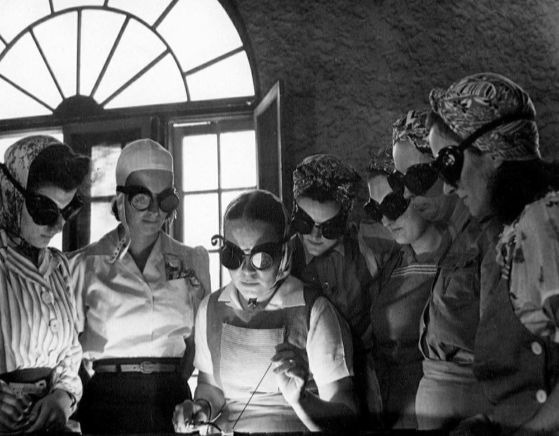You Might Not Be as Safe as You Think You Are at Work.

{source}
“The physiological states that support defense are incompatible with those that support creativity and expansive theories.” ~ Dr. Stephen W. Porges, Psychologist, Neuroscientist, and Evolutionary Biologist
Before I quit my corporate career of 15+ years, I used to regularly engage in protective behaviors that were widely accepted, but in retrospect were quite damaging to my humanity and the humanity of the people with whom I interacted.
What do I mean?
Let me know if you’re familiar with any of these behaviors in the workplace:
- Sending CYA (cover your ass) emails
- Withholding information
- Showcasing the weakness of another person
- Creating in groups and out groups
- Building non-genuine relationships
- Squeezing the last drop of productivity out of my team at all costs
Yea, it’s pretty bad, huh? I cringed just typing it.
The sad truth is that these were all behaviors that I learned and were taught to me explicitly or implicitly by the work culture and by examples set by leaders. When I looked around me, it was the norm if you wanted to succeed, or more often, not get crushed.
Industry giants compete aggressively quarter after quarter to be the top dog. And part of that system breeds offensive and defensive behaviors — it’s what we’ve accepted for decades.
But what if we can do better?
In recent years, leading companies have been flirting with the topic of psychological safety in the workplace. It’s intuitively appealing, however, hard to implement.
What Is Psychological Safety?
Psychological safety is the state of feeling protected from harm or other non-desirable outcomes that allows a person to express his/her true opinions, authenticity and creative risk-taking without negative consequences on self-image, status or career.
Psychological safety originates from the studies of trauma and polyvagal theory where research showed that an unsafe environment can be detected without our awareness, influence our physiology, and block our most effective thinking and creativity (Porges, 1994). A sense of threat in the environment turns off the parts of our brain responsible for higher thinking (Van Der Kolk, 2014).
We can’t will this away or decide to react in a different way. This happens because the human body shifts into a survival fight/flight/freeze mode when threat is detected.
On a side note, the freezing effect is experienced with even greater intensity for people who have experienced trauma at any point in their lives, which is most of us (three out of five adults in the U.S. experienced childhood trauma according to the largest national ACE study).
Although research has been around for decades, psychological safety at work is a newer concept that leading companies are now exploring and adopting. As a former management consultant who has seen the inner workings of many Fortune 500 companies, I know how difficult it is to create a positive workplace culture, especially one that emphasizes cultivating psychological safety.
How Can an Unsafe Environment Harm an Organization?
Unlike machinery, we humans have fundamental needs and requirements in order to do our best work. We need to feel the people around us care about us as individuals, and not just what they can get out of us. We need autonomy of time, thought and action. We need to feel like the work we do feeds our purpose in life. We need to feel like we make an impact. We need rest, nourishment and safety.
These are not good to haves, but rather essential for human development, actualization, and well-being.
The dangerous effects of an unsafe workplace for employees are countless related to physical and mental wellness and personal well-being, including chronic stress and suppression of the immune system and healing (Porges, 2017). As for the company’s wellness, negative impacts include:
- Suppressed innovation and creativity
- Lack of healthy risk-taking and exploring the unknown
- Lack of sustainability in ideas and good talent that impact the bottom line
- Lack of productivity
Companies Who Can Create a Psychologically Safe Culture Will Win.
It’s one of the most impactful things an organization can do to improve innovation, creativity, meaning, engagement, community, loyalty, effectiveness and productivity.
No different to any other psychosocial endeavor we humans aspire to, such as love, empathy, connection, altruism, psychological safety can be elusive and hard to standardize and implement at large scale. However, I believe it can be done with a non-egoic and enlightened leader.
For organizations, many view these cultural attributes as selling points as part of their recruiting campaign for their companies. The danger is if the culture doesn’t match up with the marketing, your talent will flee, and they will spread the word on false marketing. Nobody likes a liar.
Often, a deeply meaningful concept such as psychological safety can become another regulation to be followed by employees and policed by HR or Legal. And that would be ineffective and ironic.
This isn’t about getting people who are demonstrating bad behavior. We are not trying to perpetuate the cycle of hurt people hurt people. We do want to inform what’s unhelpful and give people a chance to learn. It’s first and foremost, educating the organization about the real missed opportunities if we don’t shift our mindset and change the way we interact with each other.
The intention here is to disrupt the organization’s automatic thoughts and behaviors and challenge us to become better humans, who in turn will create better organizations. We don’t need to continue the cycle of aggression, zero-sum or win/lose mentality, all-business-no-heart and frankly, trauma in the workplace. As the global workforce evolves and awakens, so must organizations in order to thrive.
How Do We Know When We’re Unsafe?
For employees, these are some signs your workplace may not be psychologically safe:
- Toxic leadership: You work with leaders who lack self-awareness and are self-serving, using their position of power to gaslight, intimidate, manipulate or coerce to help them get what they want, irrespective of the other person’s position.
- Lack of communication: You find out about decisions made after they have been implemented. People communicate indirectly, sending messages through others. People withhold information or give misleading information.
- Violation of your personal truth: You are asked to betray yourself or others to serve the betterment of the leaders and/or the company. This can involve sacrificing your honesty, integrity, personal time, wellness, and well-being.
- Suppression of your authentic self: You feel like you will be harshly judged or experience negative career consequences if you express your true self or opinion. You do not speak up because you have seen the detriment of others when they do.
- Protective behaviors: You engage in or see others engage in behaviors such as regular CYA (cover your ass) emails, secret-alliances, side-whisper meetings before or after the actual meeting, informally getting the scoop on someone before you have to work with him/her, or constantly having to air-cover someone or have someone provide air-cover for you.
For leaders, what are some examples that create an unsafe work environment?
You ask your employees to or you yourself:
- Develop non-genuine relationships
- Deliberately sabotage others’ success
- Regularly put others in positions where they are under-supported
- Regularly assume the role of a scapegoat
- Are regularly seen as the outsider and treated like other
- Are forced to sell something that you don’t believe in
- Demand others of protected personal time
- Ask others to sacrifice wellness and well-being (regular jet lag, missed meals, missed time with family, lack of sleep, lack of exercise)
- Asks others to lie and embellish
How Do We Foster Safety?
What can organizations and leaders do to foster psychological safety?
- Make your organizational values mean something: For example, is bureaucracy one of your organizational values? No? That’s interesting because that’s the behavior that is repeated every day in your organization through archaic policy, rigid processes and hierarchical communication and decision-making. Compare your organizational values with everyday behaviors. They should align. If not, your organizational health is at risk.
- Do the work on yourself: Honestly examine your behavior. Do you demonstrate any of the behaviors mentioned in the article? If so, it doesn’t mean you’re a bad person. Most likely, it’s what you were taught. This is an opportunity to do things differently. Some things to get you started on working on yourself: attend a self-awareness and ‘blind spots’ training (if your organization doesn’t offer it, there are a lot of retreats and conferences out there). Develop a practice of stillness and learn to meditate. Get to know your people as people and not as roles and titles. Listen more, speak less. Ask the kinds of questions to get to know your employees better, as if there weren’t anything in it for you.
- Hold other leaders accountable: Start with yourself and educate others on the opportunity cost and damage a psychologically unsafe environment can create in an organization. Once others know, make an agreement to hold each other accountable.
- Create a culture of open dialogue where varying perspectives can be heard.
- Build in psychological safety as a value in the organization and tie it to how leaders are identified, assessed and promoted.
What Can You Do If You Are Currently Working in an Environment That Is Psychologically Unsafe?
Keep in mind, psychological safety is not binary, but experienced on a spectrum. Individuals are unique, so the perception of safety is relative person to person. Consider options accordingly.
- Leave: When you prioritize your well-being and your desire to feel genuine, connected and supported about the work that you do, the choice becomes easy.
- Have an honest conversation with the people you work with. Observe how people respond to your experience and honesty. This will give you insight into whether this is a culture that values people.
- Communicate: Communicate your needs and experiences. The workplace is an environment prone to foster misunderstandings. Rather than interpret someone’s behavior or words or mind-read a situation, take the opportunity to express your confusion or how you’ve experienced an interaction to facilitate understanding.
- Channel your experience into a learning program that educates and promotes psychological safety to your organization and influence change.
- Look for ways to create feelings of safety: Find mentors and peers who are supportive and share similar values. Model the behavior that you want to see and create that environment for someone else.
- Join and/or lead a community: Data shows the more friends, not just colleagues, you have at work, the happier you are. It’s hard to develop true friendships during work meetings. Consider joining an interest group that is unrelated to work, like sports, reading, gender, faith, volunteering, etc. Bonus: if you’re able to lead an interest group at work, you’ll be able to exercise your agency and authority, which will give you an increased sense of well-being.
Just imagine what we can do when we up-level ourselves and take care of those around us to take care of the world. In my imagined world, maybe the workplace doesn’t have to be a major source of stress in people’s lives. Maybe the workplace becomes a source of support and connection in people’s lives where people feel cared for and safe.
In that world, organizations can have real power — the power of loyal, healthy, vibrant, engaged and inspired employees.
***
 Ruth Kao Barr is the founder of My Breathing Mind — mental & emotional well-being coaching. She helps busy people clear the noise and reconnect with the self to experience a more meaningful life. She regularly publishes well-being tips and mini-blogs on Instagram.
Ruth Kao Barr is the founder of My Breathing Mind — mental & emotional well-being coaching. She helps busy people clear the noise and reconnect with the self to experience a more meaningful life. She regularly publishes well-being tips and mini-blogs on Instagram.
